The Three Phases of Marvel’s Adam Warlock: Last Half of Part Two – The Thanos Arc
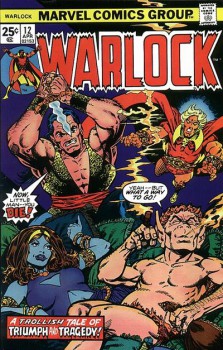 Adam Warlock was one of those brooding, tragic, lonely heroes I gravitated to as a thirteen-year old, along with Dr. Strange and Son-of-Satan and the oddball Defenders. I’ve broken up Warlock’s chronology into the three phases. I covered the first, the pre-Jim Starlin era, in my first post. I covered the first half of Jim Starlin’s 1975-1977 run, the Magus saga, in my second post.
Adam Warlock was one of those brooding, tragic, lonely heroes I gravitated to as a thirteen-year old, along with Dr. Strange and Son-of-Satan and the oddball Defenders. I’ve broken up Warlock’s chronology into the three phases. I covered the first, the pre-Jim Starlin era, in my first post. I covered the first half of Jim Starlin’s 1975-1977 run, the Magus saga, in my second post.
Today, I’ll discuss the last half of Starlin’s run in the 1970s, where Thanos plays the big heavy. As always, this post is nothing but spoilers, so read it with your eyes closed if you still haven’t read Warlock. If you’d prefer to read the comics first, they’re all available at comixology.com; today’s Adam story covers Warlock 12-15, Marvel Team-Up 55, Avengers Annual 7 and Marvel Two-in-One Annual 2.
So, although Thanos helped Adam Warlock killed his future evil self in Warlock 11, he doesn’t come back immediately. Thanos is the Titan with a plan, and so Starlin takes a couple of episodic detours.
First, Pip the Troll, the moral degenerate who is Adam’s only friend, avoids arrest by trying to spring a prostitute from her pimp. Hilarity and tongue-in-cheek ensue. I’ve never been a Pip fan, but I get how Adam’s unique and tragic fate means he gets to have one friend in life (one and a half if you count Gamorra).
Then Adam fights the Star-Thief, another original and surreal creation of Starlin’s. A man born on Earth, with a functioning brain but bereft of the five senses, the Star-Thief is completely trapped in his mind. With nothing else, he explores the inner parts of his brain, gaining tremendous power and a grudge against humanity that makes him want to extinguish the stars.
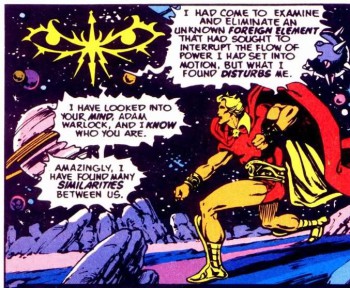 This oddly foreshadows Thanos’ own plot, and so, upon rereading feels a bit redundant, but action-wise and visually, it is a striking game of cat-and-mouse as Adam crosses the galaxy, fighting everything Star-Thief can throw at him. The end is surprising on a few levels, and despite the fact that it is not connected to Adam’s main fate per se, it remains as memorable to me as any other part of his compelling life.
This oddly foreshadows Thanos’ own plot, and so, upon rereading feels a bit redundant, but action-wise and visually, it is a striking game of cat-and-mouse as Adam crosses the galaxy, fighting everything Star-Thief can throw at him. The end is surprising on a few levels, and despite the fact that it is not connected to Adam’s main fate per se, it remains as memorable to me as any other part of his compelling life.
But none of this saving of star systems and the billions of their inhabitants consoles Adam, who remains as lonely and out-of-place as before, and is walking around with the knowledge that in a short time, he will lose all that is valuable to him, see all his works undone, and that he will die with bitterness (see my last post for more on that).
Warlock had always been an identity seeker, a philosopher and an introspective, and Starlin explores that in Adam’s struggle with the vampiric soul gem. It’s powerful character stuff, very emotional, underlining the tragedy of this hero.
Returning to Earth, Warlock encounters Spider-Man on the Blue Area of the Moon (illustrated by the most excellent John Byrne), along with the Stranger (a cosmic villain from the early issues of the X-Men), who has one of the infinity stones on his forehead. He has come to acquire another infinity stone, specifically the one belonging to the Gardner (one of the Elders of the Universe), but he’s also happy to take the one on Warlock’s brow too.
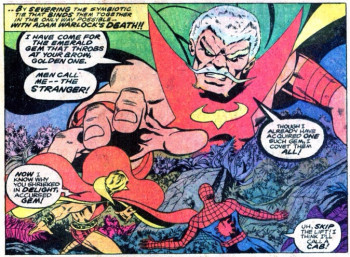 This is the first we hear of Warlock’s soul gem being one of the six infinity gems. Warlock and the Gardner are able to defeat the Stranger together, and Warlock takes Spider-Man home.
This is the first we hear of Warlock’s soul gem being one of the six infinity gems. Warlock and the Gardner are able to defeat the Stranger together, and Warlock takes Spider-Man home.
Then the main act begins. Thanos has left Gamorra, his assistant, for dead, where Adam Warlock will find her and discover Thanos’ plan. Thanos is a nut-bar, of course, but he’s incredibly powerful and he’s Reality’s Champion of Death. And after the battle on the moon, in turns out that Thanos has assembled five of the six infinity gems to create a super-weapon.
With no all-powerful Magus around to stop him, Thanos intends to press his romantic suit with Death. Does he intend to bring her flowers? No, he’s going to extinguish the stars as a gift to convey his feelings. Not my idea of a first date, but I’ve heard of worse. And you’ve got to admit, neither Thanos nor Starlin think in small terms.
So Warlock goes to get the Avengers for help. This means that Thanos has got the mightiest of Earth’s heroes in his grill. When they enter Thanos’ space station, Warlock finds his best friend Pip brain dead, courtesy of Thanos, leaving Warlock alone in the world.
Warlock goes toe-to-toe with Thanos. The Champion of Death deals Warlock a fatal blow with some of the most villainous dialogue ever:
Die, Adam Warlock. My Mistress awaits you. Tell her I follow shortly, bringing an offering of undreamed of magnitude… the stars.
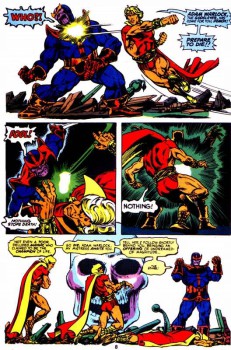 Thor and Iron manage to destroy Thanos’ weapon, and Thanos flees, but it obviously ain’t over. In the meantime, Captain Marvel witnesses a strange sight. The Adam Warlock from two years earlier (from Warlock #11, explained in my last post) has travelled two years into the future to talk with the dying Adam Warlock in the present.
Thor and Iron manage to destroy Thanos’ weapon, and Thanos flees, but it obviously ain’t over. In the meantime, Captain Marvel witnesses a strange sight. The Adam Warlock from two years earlier (from Warlock #11, explained in my last post) has travelled two years into the future to talk with the dying Adam Warlock in the present.
Gamorra is dead. Pip is dead. Adam had failed to control his vampiric soul gem. He did not stop Thanos. He is a failed, lonely creature, and he just wants his past self to take his soul, and he gets his wish. This is a powerful moment in comics, steeped in pathos and sacrifice.
But this is not the end. Inside the soul gem is a kind of heaven, without pain and without strife and he is reunited and reconciled with all the souls he’d ever fed to his gem, including Gamorra and Pip. And for fans of Adam Warlock, this is the bittersweet reward for all that Adam has tried to do and did accomplish.
But this is not the end for Thanos either. A cosmic being communicates with Spider-Man in a dream and shows him that Thanos’ flight was only a ruse, and that he came back and trounced the Avengers. And although he lost his first weapon, he takes the soul gem off the forehead of the late Adam Warlock and uses it to power the weapon that will destroy the Earth’s sun, as a smaller gift to Death.
Spider-Man goes to the Thing and they go up to try to rescue the Avengers and stop Thanos, but they are wildly outclassed. The Thing is taken out, but Spider-Man frees the Avengers. It turns out they’re not enough. Thanos makes short work of even Thor. This is one of those “oh crap” moments in comics. Thanos took out Thor twice…
But the powers of Reality are moving the chess pieces and Spider-Man knocks over a glass globe containing the late Adam Warlock’s soul gem. And from it emerges the soul of Adam Warlock, with all the power of an infinity gem. Warlock comes at Thanos as the avenger and hero he is and turns the psychotic death-stalker to stone.
Take a breath.
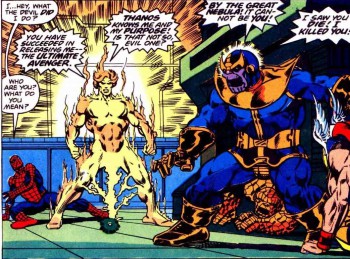 This is pretty cosmic and overwhelming. A good superhero story needs a good heavy, and short of the Magus (the evil version of Adam Warlock) and Darksied (who seems a lot like the DC version of Thanos) there ain’t nobody who poses so much danger not just to the heroes, but to the cosmos itself.
This is pretty cosmic and overwhelming. A good superhero story needs a good heavy, and short of the Magus (the evil version of Adam Warlock) and Darksied (who seems a lot like the DC version of Thanos) there ain’t nobody who poses so much danger not just to the heroes, but to the cosmos itself.
The largest forces in the Marvel Universe, like Chaos and Order, and Death and Life, are players in Starlin’s superhero space opera. And although he was not able to save Counter-Earth as the messiah, the two sacrifices of Adam Warlock, his soul and his life, saved the stars.
And despite the fact that the Avengers occasionally fought over the Cosmic Cube with cartoonish villains, Starlin’s tone and the involvement of these cosmic entities with some Michael Moorcock-flavored dread made this part of the Warlock saga among the most profound stories for a decade on either side. Starlin took his material and his readers seriously and there’s nothing better a creator can do in my books. The only other place to get this scale of conflict and stakes was Doctor Strange.
This being comic books, Adam Warlock would make a return in 1991, written by Jim Starlin again with the same gravitas. It was a popular run in the 1990s and I’m happy that the MCU is going to try to do something with Adam Warlock in movies in the next 5 years. I hope they do the character and the cosmic struggle justice.
On the Warlock comics front however, I’ll argue in my next post that although the 1990s Warlock carries some brilliant cosmic peril involving much of the MCU, stylistically and tonally, something is missing after his resurrection, leaving the 1975-1977 period as my favorite.
Derek Künsken writes science fiction, fantasy and horror in Ottawa, Canada. He tweets from @derekkunsken and his website from www.derekkunsken.com. His next space opera story Pollen From a Future Harvest is hitting the newsstands in late May in the July, 2015 Asimov’s Science Fiction.
I always wondered if Starlin nicked the vampire jewel from Moorcock’s Dorian Hawkmoon (Jewel in the Skull came out in ’67, I think.)
Hey Akomins! I think that there’s a lot of Moorcock influence in Starlin’s Warlock (I would say Corum, Elric, and Hawkmoon), much like the early 1970s Doctor Strange was very Cthulhu-flavoured. Whether I would go so far as to say he swiped ideas, I don’t think so. I know as a writer that there are lots of ideas laying around that I want to try out: themes, images, relationships, etc. Luckily for me, Moorcock and Lovecraft had themselves picked up themes and imagery from earlier artists and writers, so although they put their spin and personalities on them, the archetypes are available to those who follow. Tolkien likened the idea-sharing process to composting what you’ve read and then using the mulch.
Thanos is one of my favorite villains.